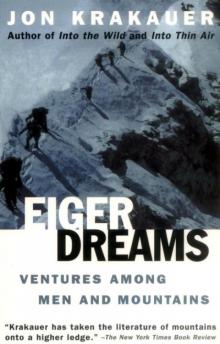- Home
- Jon Krakauer
Eiger Dreams: Ventures Among Men and Mountains Page 2
Eiger Dreams: Ventures Among Men and Mountains Read online
Page 2
During our third week of waiting for the weather to break, Marc and I rode the train down into Wengen and Lauterbrunnen to find relief from the snow. After a pleasant day of taking in the sights and sipping Rugenbrau, we managed to miss the last train up to Scheidegg and were faced with a long walk back to the tents. Marc set out at a blistering pace to try to make camp before dark, but I decided I was in no hurry to get back under the shadow of the Eiger and into the snow zone, and that another beer or two would make the hike easier to endure.
It was dark by the time I left Wengen, but the Oberland trails, though steep (the Swiss, it seems, do not believe in switchbacks) are wide, well maintained, and easy to follow. More important, on this path there were none of the electrified gates that Marc and I had encountered on a rainy night the week before (after missing another train) while walking from Grindelwald to Scheidegg. Such gates are installed to curtail bovine trespassers and are impossible to see in the dark after a few beers. They strike a five-foot nineinch body at an uncommonly sensitive point precisely six inches below the belt, and with one's feet clad in soggy Nikes they deliver a jolt of sufficient voltage to bring forth confessions to crimes not yet committed.
The walk from Wengen went without incident until I neared the treeline, when I began to hear an intermittent roar that sounded like someone goosing the throttle of a Boeing 747. The first gust of wind hit me when I rounded the shoulder of the Lauberhorn and turned toward Wengernalp. A blast came from out of nowhere and knocked me on my butt. It was the foehn, blowing down from the Eiger.
The foehn winds of the Bernese Oberland-cousin of the Santa Ana winds that periodically set Southern California on fire and the chinooks that roar down out of the Colorado Rockies-can generate stunning power. They are said to hold a disproportionate number of positive ions, and to make people crazy. "In Switzerland," Joan Didion writes in Slouching Towards Bethlehem, "the suicide rate goes up during the foehn, and in the courts of some Swiss cantons the wind is considered a mitigating circumstance for crime." The foehn figures prominently in Eiger lore. It is a dry, relatively warm wind, and as it melts the snow and ice on the Eiger it brings down terrible avalanches. Typically, immediately following a foehnsturm there will be a sharp freeze, glazing the wall with treacherous verglas. Many of the disasters on the Nordwand can be attributed directly to the foehn; in The Eiger Sanction it is a foehn that almost does Eastwood in.
It was all I could do to handle the foehn on the trail through the cow pastures. I shuddered to think what it would be like to be hit by one up on the Nordwand. The wind filled my eyes with grit and blew me off my feet over and over again. Several times I simply had to get down on my knees and wait for lulls between gusts. When I finally lurched through the door of the Bahnhof at Scheidegg, I found the place packed with railroad workers, cooks, maids, waitresses, and tourists who had become marooned by the storm. The gale raging outside had infected everybody in Scheidegg with some kind of weird, manic energy, and a riotous party was in full swing. In one corner people were dancing to a screaming jukebox, in another they were standing on the tables belting out German drinking songs; everywhere people were calling the waiter for more beer and schnapps.
I was about to join the fun when I spied Marc approaching with a wild look in his eyes. "Jon," he blurted out, "the tents are gone!"
"Hey, I don't really want- to deal with it right now," I replied, trying to signal the waiter, "Let's just rent beds upstairs tonight and repitch the tents in the morning."
"No, no, you don't understand. They didn't just get knocked down, they fucking blew away. I found the yellow one about fifty yards away from where it had been, but the brown one is gone, man. I looked but I couldn't find it anywhere. It's probably down in Grindelwald by now."
The tents had been tied down to logs, cement blocks, and an ice screw driven securely into frozen turf. There had been at least two hundred pounds of food and gear inside them. It seemed impossible that they could have been carried away by the wind, but they had. The one that was missing had contained our sleeping bags, clothing, my climbing boots, the stove and pots, some food, God only knew what else. If we didn't find it, the weeks of waiting to climb the Nordwand were going to be in vain, so I zipped up my jacket and headed back out into the foehnsturm.
By sheer chance I found the tent a quarter-mile from where it had been pitched-drifted over, lying in the middle of the train tracks to Grindelwald. It was a tangled mess of shredded nylon and broken, twisted poles. After wrestling it back to the Bahnhof, we discovered that the stove had sprayed butane over everything, and a dozen eggs had coated our clothing and sleeping bags with a nasty, sulphurous slime, but it appeared that no important gear had been lost during the tent's tour of Scheidegg. We threw everything in a corner and returned to the party to celebrate.
The winds at Scheidegg that night were clocked at 170 kilometers per hour. In addition to laying waste to our camp, they knocked down the big telescope on the gift-shop balcony and blew a ski-lift gondola as big as a truck onto the tracks in front of the Bahnhof. At midnight, though, the gale petered out. The temperature plummeted, and by morning a foot of fresh powder had replaced the snowpack melted by the foehn. Nevertheless, when we called the weather station in Geneva, we were shocked to hear that an extended period of good weather would be arriving in a couple of days. "Sweet Jesus," I thought. "We're actually going to have to go up on the wall."
The sunshine came on October 8, along with a promise from the meteorologists that there would be no precipitation for at least five days. We gave the Nordwand the morning to slough off the postfoehn accumulation of snow, then hiked through crotch-deep drifts over to the base of the route, where we set up a hastily patchedtogether tent. We were in our sleeping bags early, but I was too scared to even pretend to sleep.
At 3 A.M., the appointed hour to start up the wall, it was raining and some major ice and rockfall was strafing the face. The climb was off. Secretly relieved, I went back to bed and immediately sank into a deep slumber. I awoke at 9 A.M. to the sound of birds chirping. The weather had turned perfect once again. Hurriedly, we threw our packs together. As we started up the Nordwand my stomach felt like a dog had been chewing on it all night.
We had been told by friends who had climbed the Nordwand that the first third of the standard route up the face is "way casual." It isn't, at least not under the conditions we found it. Although there were few moves that were technically difficult, the climbing was continuously insecure. A thin crust of ice lay over deep, unstable powder snow. It was easy to see how Ragone had fallen; it felt as though at any moment the snow underfoot was going to collapse. In places where the wall steepened, the snow cover thinned and our ice axes would ricochet off rock a few inches beneath the crust. It was impossible to find anchors of any kind in or under the rotting snow and ice, so for the first two thousand feet of the climb we simply left the ropes in the packs and "soloed" together.
Our packs were cumbersome and threatened to pull us over backward whenever we would lean back to search out the route above. We had made an effort to pare our loads down to the essentials, but Eiger terror had moved us to throw in extra food, fuel, and clothing in case we got pinned down by a storm, and enough climbing hardware to sink a ship. It had been difficult to decide what to take and what to leave behind. Marc eventually elected to bring along a Walkman and his two favorite tapes instead of a sleeping bag, reasoning that when the going got desperate, the peace of mind to be had by listening to the Dead Kennedys and the Angry Samoans would prove more valuable than staying warm at night.
At 4 P.m., when we reached the overhanging slab called the Rote Fluh, we were finally able to place some solid anchors, the first ones of the climb. The overhang offered protection from the unidentified falling objects that occasionally hummed past, so we decided to stop and bivouac even though there was more than an hour of daylight left. By digging out a long, narrow platform where the snow slope met the rock, we could lie in relative comfort, head-tohead, wi
th the stove between us.
The next morning we got up at three and were away from our little ledge an hour before dawn, climbing by headlamp. A ropelength beyond the bivouac, Marc started leading up a pitch that had a difficulty rating of 5.4. Marc is a 5.12 climber, so I was alarmed when he began to mutter and his progress came to a halt. He tried moving left, and then right, but an eggshell-thin layer of crumbly ice over the vertical rock obscured whatever holds there might have been. Agonizingly slowly, he balanced his way upward a few inches at a time by hooking his crampon points and the picks of his axes on unseen limestone nubbins underneath the patina of rime. Five times he slipped, but caught himself each time after falling only a few feet.
Two hours passed while Marc thrashed around above me. The sun came up. I grew impatient. "Marc," I yelled, "if you don't want to lead this one, come on down and I'll take a shot at it." The bluff worked: Marc attacked the pitch with renewed determination and was soon over it. When I joined him at his belay stance, though, I was worried. It had taken us nearly three hours to climb eighty feet. There is more than eight thousand feet of climbing on the Nordwand (when all the traversing is taken into consideration), and much of it was going to be a lot harder than those eighty feet.
The next pitch was the infamous Hinterstoisser Traverse, a 140foot end run around some unclimbable overhangs, and the key to gaining the upper part of the Nordwand. It was first climbed in 1936 by Andreas Hinterstoisser, whose lead across its polished slabs was a brilliant piece of climbing. But above the pitch he and his three companions were caught by a storm and forced to retreat. The storm, however, had glazed the traverse with verglas, and the climbers were unable to reverse its delicate moves. All four men perished. Since that disaster, climbers have always taken pains to leave a rope fixed across the traverse to ensure return passage.
We found the slabs of the Hinterstoisser covered with two inches of ice. Thin though it was, it was solid enough to hold our ice axes if we swung them gently. Additionally, an old, frayed fixed rope emerged intermittently from the glazing. By crabbing gingerly across the ice on our front points and shamelessly grabbing the old rope whenever possible, we got across the traverse without a hitch.
Above the Hinterstoisser, the route went straight up, past landmarks that had been the stuff of my nightmares since I was ten: the Swallow's Nest, the First Icefield, the Ice Hose. The climbing never again got as difficult as the pitch Marc had led just before the Hinterstoisser, but we were seldom able to get in any anchors. A slip by either of us would send us both to the bottom of the wall.
As the day wore on, I could feel my nerves beginning to unravel. At one point, while leading over crusty, crumbly vertical ice on the Ice Hose, I suddenly became overwhelmed by the fact that the only things preventing me from flying off into space were two thin steel picks sunk half an inch into a medium that resembled the inside of my freezer when it needs to be defrosted. I looked down at the ground more than three thousand feet below and felt dizzy, as if I were about to faint. I had to close my eyes and take a dozen deep breaths before I could resume climbing.
One 165-foot pitch past the Ice Hose brought us to the bottom of the Second Ice Field, a point slightly more than halfway up the wall. Above, the first protected place to spend the night would be the Death Bivouac, the ledge where Max Sedlmayer and Karl Meh- ringer had expired in a storm during the first attempt on the Nordwand in 1935. Despite its grim name, the Death Bivouac is probably the safest and most comfortable bivouac site on the face. To get to it, however, we still had to make an eighteen-hundred-foot rising traverse across the Second Ice Field, and then ascend several hundred devious feet more to the top of a buttress called the Flatiron.
It was 1 P.M. We had climbed only about fourteen hundred feet in the eight hours since we'd left our bivouac at the Rote Fluh. Even though the Second Ice Field looked easy, the Flatiron beyond it did not, and I had serious doubts that we could make the Death Bivouac-more than two thousand feet away-in the five hours of daylight that remained. If darkness fell before we reached the Death Bivouac, we would be forced to spend the night without a ledge, in a place that would be completely exposed to the avalanches and rocks that spilled down from the most notorious feature on the Nordwand: the ice field called the White Spider.
"Marc," I said, "we should go down."
"What?!" he replied, shocked. "Why?"
I outlined my reasons: our slow pace, the distance to the Death Bivouac, the poor condition the wall was in, the increasing avalanche hazard as the day warmed up. While we talked, small spindrift avalanches showered down over us from the Spider. After fifteen minutes, Marc reluctantly agreed that I was right, and we began our descent.
Wherever we could find anchors, we rappelled; where we couldn't, we down-climbed. At sunset, below a pitch called the Difficult Crack, Marc found a cave for us to bivouac in. By then we were already second-guessing the decision to retreat, and we spent the evening saying little to each other.
At dawn, just after resuming the descent, we heard voices coming from the face below. Two climbers soon appeared, a man and a woman, moving rapidly up the steps we had kicked two days before. It was obvious from their fluid, easy movements that they were both very, very good climbers. The man turned out to be Christophe Profit, a famous French alpinist. He thanked us for kicking all the steps, then the two of them sped off toward the Difficult Crack at an astonishing clip.
A day after we had wimped-out because the face was "out of condition," it appeared as though two French climbers were going to cruise up the climb as if it were a Sunday stroll. I glanced over at Marc and it looked like he was about to burst into tears. At that point we split up and continued the nerve-wracking descent by separate routes.
Two hours later I stepped down onto the snow at the foot of the wall. Waves of relief swept over me. The vise that had been squeezing my temples and gut was suddenly gone. By God, I had survived! I sat down in the snow and began to laugh.
Marc was a few hundred yards away, sitting on a rock. When I reached him I saw that he was crying, and not out of joy. In Marc's estimation, simply surviving the Nordwand did not cut it. "Hey," I heard myself telling him, "if the Frogs get up the sucker, we can always go into Wengen and buy more food, and then go for it again." Marc perked up immediately at this suggestion, and before I could retract my words he was sprinting off to the tent to monitor the French climbers' progress through binoculars.
At this point, however, my luck with the Nordwand finally took a turn for the better: Christophe Profit and his partner only got as far as the Rote Fluh, the site of our first bivouac, before a large avalanche shot past and scared them into coming down, too. A day later, before my Eiger luck could turn again, I was on a jet home.
JUST WEST OF PUEBLO, COLORADO, THE FLAT EXPANSE OF THE GREAT Plains gives way to the first nascent ripples of the Rocky Mountains. Here, among the scrub oak and cactus, a massive boulder the color and texture of weathered brick rises fifteen feet above a parched meadow. The rock is much longer than it is high, with a gently overhanging flank that flares out of the sand like the rusting hull of a long-beached ship. To the untrained eye, the face of the boulder looks nearly smooth: a rounded bulge here and there, a few tiny holes, now and then a pencil-thin ledge. There appears to be no way for a person to climb this chunk of sandstone. Which is precisely what draws John Gill to it.
Gill dusts his fingers with gymnasts' chalk and walks purposefully up to the boulder's base. By clinging to small nicks on the rock's surface and balancing on pea-size nubbins, he somehow manages to pull his body off the ground, as if by levitation. To Gill, the boulder's steep face is a puzzle to be solved with finger strength, creative movement, and force of will. He puts the puzzle together piece by piece, delicately shifting his weight from tiny hold to tiny hold until he finds himself hanging from his fingertips three feet beneath the boulder's crest. Here he seems stymied; his feet dangle uselessly in space and his position is so tenuous that he can't let go with either hand to rea
ch higher without falling.
Wearing an expression of beatific calm that gives no clue to the terrible strain his muscles are under, Gill fixes his eyes on the top, dips his shoulders slightly, and then springs suddenly for the crest from his pathetic handholds. Completely airborne, his body travels upward mere inches before the apogee of its flight is reached, but in that moment, just as he begins to be pulled earthward, his left hand shoots for the crest of the boulder like a snake striking a rat and clamps onto it securely. A few seconds later Gill is standing on top.
John Gill is a living legend to mountain climbers on three continents, a man held in awe by the best in the sport. Customarily, a person gains entry into the mythology of mountaineering through death-defying deeds in the Himalaya, Alaska, the Alps, or the huge granite walls of Yosemite. Gill's reputation, though, rests entirely on ascents less than thirty feet high: He has joined the elite company of Hermann Buhl, Sir Edmund Hillary, Royal Robbins, and Reinhold Messner by ascending nothing bigger than boulders.

 Into the Wild
Into the Wild Into Thin Air
Into Thin Air Under the Banner of Heaven: A Story of Violent Faith
Under the Banner of Heaven: A Story of Violent Faith Eiger Dreams: Ventures Among Men and Mountains
Eiger Dreams: Ventures Among Men and Mountains Three Cups of Deceit: How Greg Mortenson, Humanitarian Hero, Lost His Way
Three Cups of Deceit: How Greg Mortenson, Humanitarian Hero, Lost His Way Under the Banner of Heaven
Under the Banner of Heaven Missoula
Missoula Classic Krakauer
Classic Krakauer